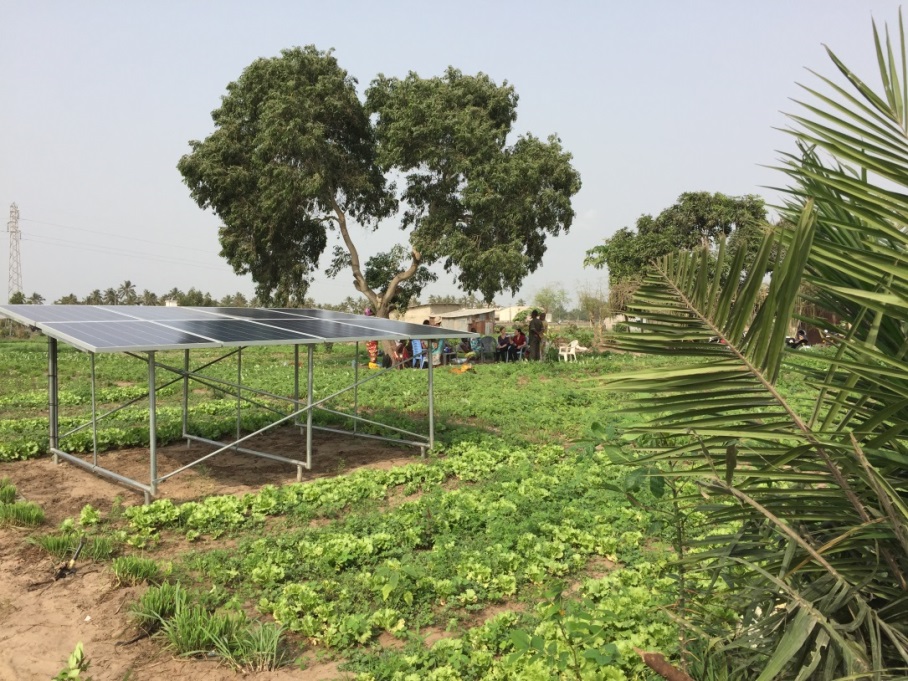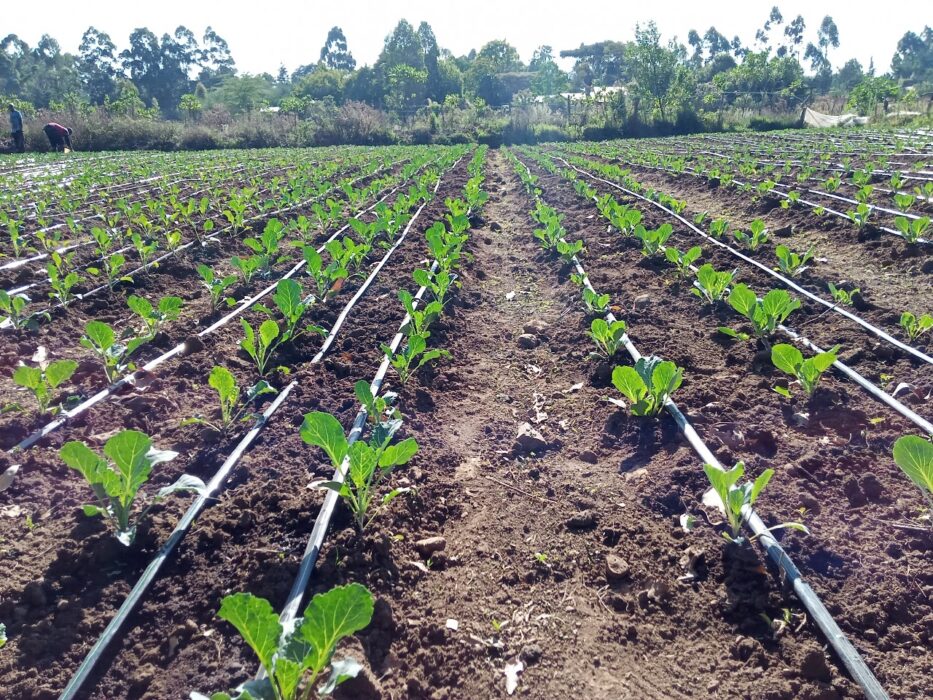
Drip Irrigation System Layout
Grekkon Limited’s drip irrigation system layout is done for all farm sizes, and all crops. There 3 ways in which the company gathers data to develop a drip irrigation system layout
- Farmers provide detailed sketches as directed by the company from which a drip irrigation system layout is developed. This sketch will include; the farm dimensions in meters, the water source type, distance to the water source from the farm, details of any existing irrigation infrastructure, any existing roads or pathsways, any none farmable sections (rocky areas, wet lands, built up locations etc), planting beds layout, the direction(s) of slope, and the total vertical elevation
- Provide the farm’s map coordinates from which the company assesses the farm layout using satellite technology
- Conduct a physcal site assessment visit. This is only carried when 2 above cannot be done
The company only charges for the 3rd service to cover the logistical costs


A sample drip irrigation system layout for a 40 acre farm by Grekkon Limited
The company’s irrigation engineers will conduct a physical visit on a prospective farm to determine the following
i. The water source. The company measures the water volume, and analysis the quality. The volume determines the irrigation system to use, the size of the water pump, and the acreage covered. For intance, a farmer with a borehole yielding 15 cubic litres per hour is best positioned to irrigate using drip irrigation. His irrigated acreage will not exceed 30 acres for optimal water utilisation. On the other hand, a farmer by a large permanent river or lake water source will irrigate hundreds of acres using any irrigation method preferred. The water quality determines the type of filtration system to install.
A screen filter is for water under low pressure with a negligible amout of suspended dirt or other particles. A disc filter is preferred for water under high pressure, with a negligible to a modest amount of suspended dirt orcother particles. A sand filter is for dirty water under high pressure

A simple drip irrigation kit by gravitational flow system layout
ii. The dimensions of the farm in meters. to provide the total acreage. The acreage will determine the pipe diameter sizes, the water pump’s flow rate, and the sub-division of the irrigation blocks
iii. Slope. The elevation of the farm gives the vertical head or lift needed. This is important in determining the pressure rating of the water pump to install, the pipe diameters, the planting beds layout (these should be done against the slope), and the size of the irrigation blocks
iv. Any existing irrigation infrastructure; to determine what can be used or incorporated into the new system
v. Provide advise on security measures for key company installations such as; large water pumps, solar modules, solar inverters, control panels, cables, and other high value accessories
Key Requirements To Install A Drip Irrigation System
1. A water source
2. A water pump and piping mechanism to move this water from the source to the tank or directly to the drip irrigation system.
3. Water storage tank if you’re using gravity to irrigate
4. A tank connector
5. Pipes for the mainline and sub-main line.
6. Mainline and sub mainline fittings
7. Drip irrigation water filter
8. Drip irrigation pipes
9. Accessories
10. Ball valves
Steps To Follow In Designing A Drip Irrigation Layout
- Determine where the water pump or water tank will be placed. Water tanks are used for small acreage gravity flow irrigation, and should be placed at highest elevation to allow ease of water flow by gravity
- The main line originates from the water tank or water pump. The size of the main line determines the volume of irrigation water delivered to the farm in every irrigation session. The larger the farm, the greater the diameter of the mainline
- The water filter is connected along the main line
- A venturi fertigation system where needed is along the main line. The venturi fertigation system is a chemifertigation centre that allows drenching of chemicals and fertiliser through the drip irrigation system
- The air release valves are along the main line. Air release valves are installed where the water pressure is high. This is in steep elevations, or if the water is chanelled via a high pressure water pump. They prevent air locks in the irrigation system. Air locks dramatically reduce, or cease water flow in the system
- A sub main line will be connected to the main line along its way using hydrants. Hydrants are points from which irrigation in a block is controlled from. They can be automated using solenoid valves, or manually operated through ordinary valves. The decision to have sub main lines is a factor of the farm size. In small drip irrigation set ups, the drip pips are directly connected to the main line. In larger acreage, the drip line originate from the sub mainline
- The main line is always larger in diameter than the sub main line. The diameter of the sub main line is determined by the size of the main line. The larger the latter, the larger the sub main line is
- The hydrants are positioned at the beginning or end of every irrigation block
- Planting beds are done against the slope. This is to slow down erosion, and allow better water percolation in the soil during the rainy season. The width of the planting bed is determined by the crop type
- Drip lines lie along the length of the planting beds. The number of drip lines per bed depends on the crop type. E.g 2 drip lines are installed for tomato, 3 drip lines for onion or garlic, and 4 drip lines for some herbs and spices

A 3 row drip layout per bed installed in Birikani area of Kajiado county
Solar Irrigation Kits In Kenya
Grekkon Limited’s solar irrigation kits in Kenya utilise soalr energy as the primary power source to pump water, and distribute it in the farm. Our solar irrigation kits are a clean energy technology that reduces greenhouse emissions. They substitute fossil fuels as an energy source. The company supplies and installs these kits within the east Africa region mainly for smallholder farmers
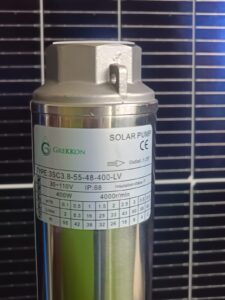
A Grekkon solar submersible water pump for smallholder farmers
Solar Irrigation Kits In Kenya
Components
- A water source. This will be a deep or shallow well, a dug out or natural water reservoir, a river, lake or a an artificial water storage unit
- Mounting structure for solar photovoltaic (PV) panels
- A solar pump. This will be either a submersible solar electric water pump (ideal for wells), or a surface solar water pump. The pump will be fixed or portable depending on the size
- A solar water pump controller
- The irrigation system. Most solar powered irrigation systems have the drip irrigation kit as the watering component. This is because it operates under low volume, low pressure. However, some farmers opt also for the rain hose irrigation kit depending on the crop type, available water volume, and the pumping pressure. The rain hose kit works best at high water volume, under high pressure
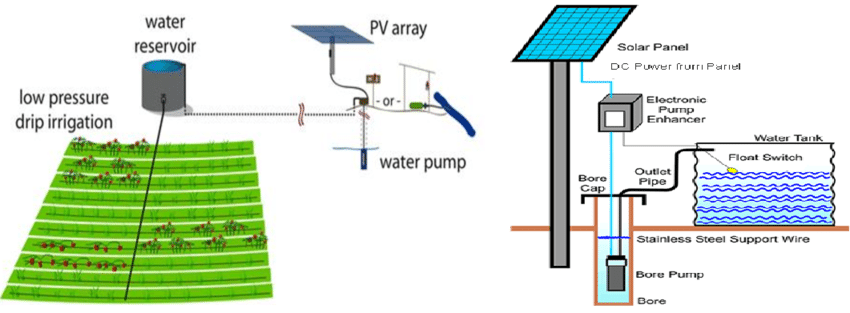
Components of a solar irrigation kit
Solar Irrigation Kits In Kenya
How they work
- Electricity to run the solar water pump is generated by solar PV panels. They absorb the sun’s energy converting it to direct current (DC) electical energy
- This DC energy flows into an inverter/ controller which converts it to alternating current (AC) electrical energy
- The AC power is channeled to the motor, which runs the pump
- The pump distributes water to the irrigation system
The number of panels used depends on the motor size. The larger it is, the higher the number of PV panels required
A farmer will opt to irrigate by pumping directly to the irrigation system, or to an elevated storage unit, from which the water flows to the irrigation system by gravity
Solar Irrigation Kits In Kenya
Benefits
i. It allows for water pumping in electricity off-grid locations by generating its own solar electric power
ii. It reduces the emissions of greenhouse gases as it does not run on fossil fuels
iii. Farmers produce all your round so long as irrigation water is available
iv. It has near zero maintainance and operating costs, as there’s no drudgery during irrigation
v. There are no opertional costs unlike fossil fuel powered water pumps that require diesel or petrol purchases to run
Solar Irrigation Kit Price In Kenya
Drip Irrigation Kit
| Acreage | Price (Kes) |
| 0.25 | 105,000 |
| 0.5 | 145,000 |
| 1 | 230,000 |
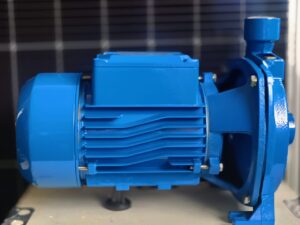
A Grekkon surface solar water pump for irrigation
2. Rain hose kit
| Acreage | Price (Kes) |
| 0.25 | 85,000 |
| 0.5 | 110,000 |
| 1 | 145,000 |
Solar Irrigation Kits In Kenya
FAQs
1. What is a solar power irrigation system?
It is a unit composed of a solar pump, and an irrigation kit
2. Do solar panels work at night?
No they don’t. However, a farmer can choose to set up a battery to store power during the day, to power the irrigation system at night
3. Do solar panels work in the rain?
They work optimally under clear skies. Their efficiency is dramatically reduced with heavy cloud cover
4. How many solar panels does it take to run a water pump?
It depnds on the size of the motor attached to the solar pump. The greater it is, the higher the number of solar panels required
5. What is the weakness of a solar pump?
They do not work if there is no solar energy provision
6. What solar pump is best for agriculture?
Grekkon limited has the best solar powered water pumps for agriculture because they are designed for small, and medium holder farmers in Africa who constitute about 87% of the farmeing community on the continent
7. How long do solar water pumps last?
For more than 20 years with regular servicing
8. Does a solar water pump need a battery?
No. It will work with the current received directly from the solar panels
9. How deep can a solar pump work?
It depends on the head of the submersible solar pump. Some work in wells as deep as 500M
10. Do you need an inverter with solar panels?
Yes if the pump uses AC current. The inverter will convert the DC to AC. However, a DC pump will not require an inverter
Fossil fuel powered water pumps carbon emissions calculation
The downside of fossil fuel powered water pumps is CO2 emissions, which contribute to global warming, the chief reason for negative climate change being experienced today. To calculate the quantity of CO2 emission from a diesel water pump, multiply the fuel usage in litres by a factor of 2.67. For example; a pump that consumes 100 litres of diesel per month emits 267kgs of CO2 emissions monthly. To calculate the quantity of CO2 emission from a petrol water pump, multiply the fuel usage in litres by a factor of 2.3035. For example; a pump that consumes 100 litres of petrol per month emits 230.35 kgs of CO2 emissions monthly.

Cost Of Drip Irrigation Per Acre
The cost of drip irrigation per acre in Kenya varies from crop to crop. Grekkon Limited is the top most of all drip irrigation kits suppliers in Kenya. Our drip irrigation system price in Kenya depends on the crop type. For tree crops and hedges, button drippers are installed. In vegetable crops, pre-perforated drip pipes are laid. The emitter spacing on the pre-perforated drip lines is either; 15cm, 20cm, or 30cm. A grower selects according to the vegetable crop type spacing.
We provide our growers a choice of single or double emitter drip irrigation tapes. Double emitter drip lines are helpful in high saline irrigation water locations where salt precipitates form and clog drip emitters. When one emitter is clogged, then the other one continues to irrigate at the same rate. Drip irrigation pipes for sale in Kenya by Grekkon Limited are PVC, and HDPE types
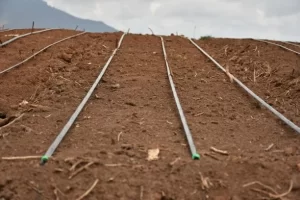
A 3-row drip per bed installation for a vegetable by Grekkon Limited in Ol-Donyo Sabuk area, Machakos county
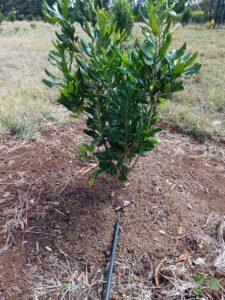
A button dripper irrigation system on macadamia in Item area, Elgeyo Marakwet county by Grekkon Limited
Cost of Drip Irrigation Per Acre
Determining Factors
- Crop type.It determines the crop spacing. Is it a fruit or vegetable garden? Fruit trees and fruit vines or runners such as melons 🍉 take less drip tape per acre. So they have the least cost. Vegetable crops take more drip lines, and are thus more expensive
- Pipe type. It is a PVC or HDPE mainline, and sub-mainline? The former is more expensive to work with
- Water pressure available. The higher the pressure, the less the number of irrigation blocks. Less irrigation blocks per acre means less fittings and accessories, so it’s less expensive. With low pressure, more irrigation blocks are created, at a higher unit cost
I. An Eighth To One Acre Drip Irrigation Kit Prices
| Crop Type | Drip Lines Per Bed | Acreage | Cost in Kes |
| Watermelon | 1 | 1/8 | 15,000 |
| 1/4 | 25,000 | ||
| 1/2 | 45,000 | ||
| 1 | 85,000 | ||
| Tomato, cabbage, chilies, capsicum, green beans, peas | 2 | 1/8 | 25,000 |
| 1/4 | 40,000 | ||
| 1/2 | 75,000 | ||
| 1 | 140,000 | ||
| Onion, garlic, herbs, spices, strawberry | 1/8 | 27,500 | |
| 3 | 1/4 | 45,000 | |
| 1/2 | 85,000 | ||
| 1 | 160,000 |
II. Fruit Tree Button Drip Kit Irrigation Prices
| Crop Type | Acreage | Cost in Kes |
| Tree Tomato/ Pawpaw/ Passion/ Coffee | 1/8 | 15,000 |
| 1/4 | 25,000 | |
| 1/2 | 45,000 | |
| 1 | 85,000 | |
| Avocado | 1/8 | 15,000 |
| 1/4 | 25,000 | |
| 1/2 | 40,000 | |
| 1 | 70,000 |
FAQS
a. How much does it cost to install a drip irrigation system in Kenya?
The tabulated cost of drip irrigation per acre in Kenya includes the cost of installation by our technicians. We conduct our installations in all of east Africa, for every grower. After installation, our agronomy team provides 4 months of free agronomy training for new farmers.
b. How much does drip irrigation cost per hectare?
The cost of drip irrigation per hectare is 2.5 times the cost provided per acre
c. How many drip lines per acre?
This is determined by the crop type. 3,000M for 1 drip row per bed, 6,000M for 2 drip rows per bed, and 8,000M for 3 drip rows per bed
4. What is the maximum length of a drip irrigation line?
Your 16mm drip irrigation line will run for 25 to 27M under gravity flow, where the head is below 10M. From 10M head, this will go up to 50M
5. How far apart are drip irrigation holes?
Our emitter spacing is; 15cm, 20cm, and 30cm
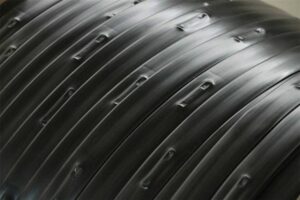
15cm drip emitter spacing on a 1,00M single emitter drip roll
6. How do I calculate drip irrigation?
- Determine the emitter spacing, for example 15cm
- Divide the drip length by this spacing to determine the number of emitters per roll. In our case, 1,000M divided by 0.15M= 6,667 emitters
- Multiply the emitters by the number of rolls per acre, for example 6 rolls, so 40,000 emitters per acre
- Multiply the emitter flow rate by the total number of emitters to get the amount of water discharged per hour. For example 1.5 litres per hour x 40,000= 60,000 litres per hour
7. Which pipe is best for drip irrigation?
HDPE pipes are the best as main and sub main lines because they have UV treatment. This means that they will be used either as surface or sub-surface pipes
8. Can you run a drip line uphill?
Yes. But the head of the flow must be higher than the vertical height of the slope
9. What pipe size should I use for drip irrigation?
The size of the main or sub main pipe installed is determined by the area under irrigation. The larger it is, the larger the pipes used
10. How do I know how long to run drip irrigation?
This is determined by the existing level of soil moisture. Run it for 20 minutes to 1 hour according to the amount of water needed
11. How do I increase the pressure in my drip irrigation system?
They are several ways to raise the irrigation water pressure in your drip irrigation system
i. Divide the farm into blocks, each of which is irrigated separately. This way, irrigation water is channeled to particular block under high pressure
ii. If it is by gravity flow, then by raising the storage elevation. This will work where raised water tanks are the source of irrigation water
iii. By introducing an external source of pressure, such a s water pump to boost the flow of irrigation water in the system
Drip Irrigation Lines and Pipes
In this drip irrigation lines and pipes piece, we will answer commonly asked questions in relation to drip irrigation
1.What is drip irrigation tape?
This is a flat thin walled LLDPE material tube with sequential emitters for irrigation
2. How long do you water with drip tape?
This depends on the crop water need at the time of irrigation. It ranges from 25 minutes to 1.5 hours. It is recommended to irrigate daily over a short duration with the same amount of water to keep the crop happy
3. Can you re-use drip tape?
Yeas you will over several growing seasons. The thicker the wall size, the longer the re-use period
4. What is the maximum length of a drip irrigation line?
1,000M
5. How much water does drip tape put out?
This depends on the emitter specifications. We supply 1.5L/ hour, 2L/hour, and 3L/hour emitters in our drip tapes
6. How much do drip lines cost?
Grekkon Limited’s double emitter drip irrigation lines and pipes for sale in Kenya tapes are categorised by thickness; 0.3mm, and 0.4mm. Both are 16mm in diameter, 1,000M long and with a choice of emitter spacing as 15cm, 20cm, and 30cm
Cost of drip irrigation tapes
| Thickness | 0.3mm | 0.4mm |
| Price | KES 7,500 | KES 8,500 |
The choice of drip line thickness depends on
- is it for out door or greenhouse installation? 0.3mm is fine in the greenhouse because it is no directly exposed to sunlight
- radiation level. where the sun’s radiation is high, 0.4mm is better

7. How much does it cost drip irrigation for 1 acre?
This depends on the crop type. Different crops have different drip irrigation piping requirements
Drip irrigation lines and pipes
By acreage pricing
| Crop Type | Lines Per Bed | Acreage | Cost in Kes |
| Watermelon, cucumber, butter nut | 1 | 0.125 | 15,000 |
| 0.25 | 25,000 | ||
| 0.50 | 45,000 | ||
| 1 | 85,000 | ||
| Tomato, cabbage, chilies, capsicum | 2 | 0.125 | 25,000 |
| 0.25 | 40,000 | ||
| 0.50 | 75,000 | ||
| 1 | 140,000 | ||
| Onion, garlic, herbs, spices, strawberry | 0.125 | 27,500 | |
| 3 | 0.25 | 45,000 | |
| 0.50 | 85,000 | ||
| 1 | 160,000 |
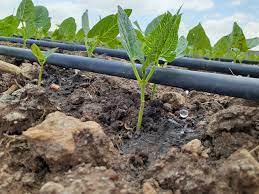
Drip irrigation on green beans by Grekkon Limited
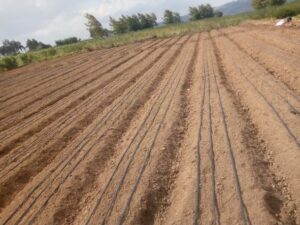
Drip irrigation pipes for onion installed by Grekkon Limited
8. What time of day is best for drip irrigation?
Early morning is highly recommended. If not, then in the evening
9.How much pressure does a drip irrigation system need?
The minimum operating pressure is 3M or 0.3 bar
10. What pipes size should I use for drip irrigation?
There are 3 lines in an irrigation set-up
- main line. This one delivers water to the farm from the source; tank, water pan, lake or river. It is the largest
- sub-main line. It is connected to the main line to supply water to the drip irrigation tubes. It is lesser in diameter than the main line
- drip irrigation tape. it supplies water directly to the crop
The pipe size is a factor of acreage. The main line diameter size on 10 acres is larger than the main line diameter size on half an acre of drip irrigation. These pipes are either HDPE or PVC types
11. How do I start my own drip?
Our technical team guides new drip irrigation farmers on starting out. These are the steps to follow
- identify the area to undertake drip irrigation. It will have a close water source
- what crop is to be grown? this will guide on the number of drip rows per bed
- what is your budget? it determines the acreage to set up the system

